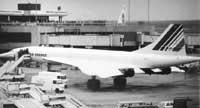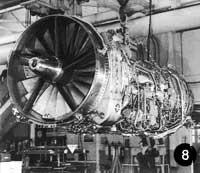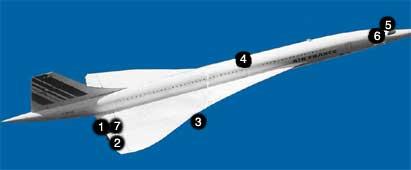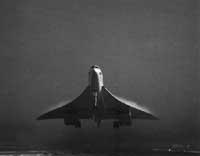Restored "Concorde"
1994/06/01 Otaolaurretxi, Jon Iturria: Elhuyar aldizkaria
British Airways and Air France are the only countries in the world that exploit the “Concorde” aircraft. Each of these companies has seven aircraft and sixteen years in the Atlantic Ocean. Air France travels daily from Paris to New York, while British Airwais travels daily from two London to New York. In addition, the “Concorde” travels weekly from London to Washington. Therefore, British Airways aircraft launch more hours in the same season, that is, they perform more “cycles”, as it is said in aeronautics.

The cycle is defined as the set of operations that take place on a commercial flight: take off the ground and ascend up to 18,000 meters high, accelerate up to the Mach 2 (double the speed of sound), move, slow down, lower and land at that speed. All this is mainly due to the mechanical stresses on the wings, central body and motors.
When the plane travels at high altitude to an atmosphere with little air (at a temperature of almost -50 ° C), so that passengers can go quiet, the body of the plane is exposed to pressure, in a typical situation of the top of a thousand five hundred meters. When the plane goes up, therefore, the body is subjected to strong tensions due to internal pressure and the absence of pressure. In addition, when the plane travels at a very personal speed heat is generated by the friction that air generates around the wings and fuselage.
Therefore, the end of the “Concorde” heats up to 127°C and the front end of the wings up to 100°C. On the other hand, keep in mind that until reaching the speed of Mach 2 the temperature of the fuselage increases slowly, but when lowering the plane downwards it cools very quickly when the speed drops and enters the lower layers of the atmosphere.
All this forces to use a complex air conditioning system for the interior of the plane. When the plane goes up or down, warm air must be inserted into the body to which the passengers go. However, when going up at high speed, cold air must be put in to prevent travelers from sweating.
These temperature changes generate stresses in the structure, as well as aerodynamic stresses in the air. Therefore, during the construction of this plane, special aluminum alloys were obtained that support high temperatures without large deformations and without losing their mechanical properties. Cegedur's AU 2 GN aluminum type is the most widely used and after heating at a temperature of 130°C for 30,000 hours, the extension has been reduced to 0.02%.
This extension is very small mechanically, but can only be due to material fatigue. This is because during flight the material is heated and cooled, generating tensions. Therefore, the material was subjected to a laboratory of 20,000 cycles (already mentioned above). The aluminium AU 2 GN of wings and fuselage was heated to 125 °C by infrared radiation and cooled to a temperature of -10 °C (until the plane has when descending). The tests consisted in heating the material for forty minutes and not in three and a half hours (time it takes to travel the Atlantic Ocean), but they were enough to see the tensions that occur in the metal. In addition, the material was subjected to other mechanical tests, as it had to withstand aerodynamic forces.

With all these tests, the authorities decided to approve in 6,700 cycles the material that had supported 20,000 cycles on the ground and already some of the “Concorde” of the British Airways company are approaching this figure, 6,200 launches and 17,000 hours of operation. The first three “Concorde” must therefore be withdrawn shortly for security reasons.
Another problem in the aircraft is the corrosion of the material, but in it the “Concorde” is offering better results than expected. In fact, all the ice or moisture that occurs in the plane when crossing the clouds when taking off evaporates when heated kinetically above. Therefore, the plane travels dry for most of the flight time and has no corrosion problems.
According to some reports, the health of the “Concorde” plane is very good, but there is a rule that says that up to 6,700 cycles can be done. The way to modify this standard would be to experiment in laboratory with materials and demonstrate that it supports more than 20,000 cycles. When rehearsals were made in the 1970s, after the “Concorde” the “Super-Concorde” was expected to arrive shortly, but we know that this has not had continuity.
Therefore, what Air France companies would like and, above all, British Airways would be to have available in 2005 the successor of the “Concorde” with more than 8,000 permit cycles. To do this they want to introduce some changes to the current plane. The eaves located at the rear of the wing, which turn for the plane to rise or fall, are larger to make them more efficient. The amount of air from Olympus 593 reactors has also increased to reduce consumption. (It must be said that this type of reactors is quite old and with relatively high consumption). Thus, the Atlantic Ocean will cost 1.5 tons less kerosene.
For the plane to be profitable, the fuel consumed per passenger should be reduced to a third, being able to travel 12,000 kilometers instead of 6,500 kilometers and transport 200 instead of 100 passengers. Another aspect is fuel consumption. In fact, when circulating at 20,000 meters of altitude, it will not be able to emit nitrogen oxide in the burned gases, as they would be as harmful as CFCs.
They also want to introduce improvements to the plane so that maintenance is cheaper and has less breakdown. In case of failure, the plane must return to its starting point. This means 720,000 ptas. to go fast to New York (or to Paris or London). The traveler who has paid 36,000 pounds gets angry. That is, the technical reliability of the Concorde must be improved.

1. Air intake to reactors to reduce consumption.
2. Larger spoilers to be more efficient.
3. Electronic control at the air inlet to reduce breakdowns during flight.
4th Reinforce the fuselage to last longer.
5. Hydraulic equipment monitoring system to avoid false alarms during flight.
6th Implementation of the TCAS system (Traffic Colision Avaidance System).
7. Engine parts status detection system.
8th. Olympus engines will not change.

Gai honi buruzko eduki gehiago
Elhuyarrek garatutako teknologia




